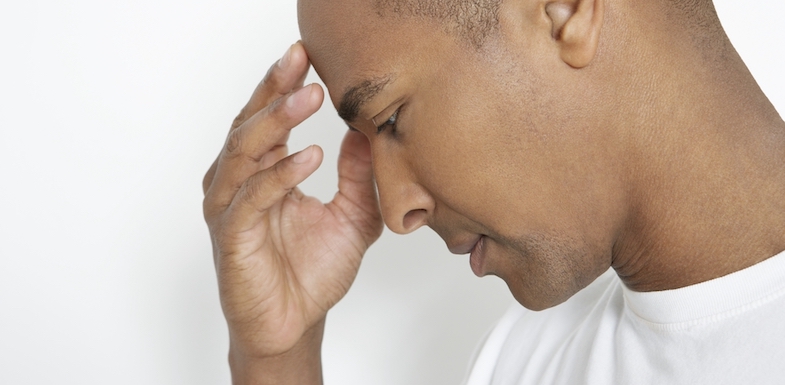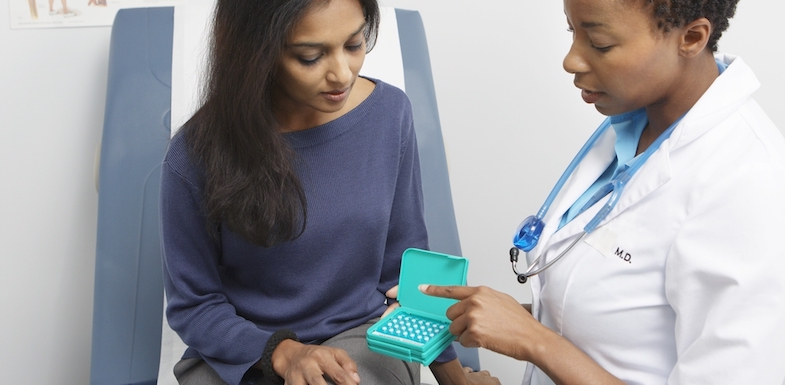How to Get Rid of a Stress Headache

Most of us have experienced a headache that seems like it will last forever. One that makes your head pound and puts you in a generally bad mood. While there are a lot of different kinds of headaches, most of us have experienced what is known as a tension headache. This type of headache is the most common and over half of all adults experienced one this last year. They affect as many as 80% of U.S. adults at some point in their lives, according to WebMD. Read on if you suffer from these headaches and are wondering how to get rid of a tension headache.
How to get rid of a tension headache, the basics
According to the International Headache Society, tension headaches are generally a short-lived, infrequent incident. These types of headaches are known as episodic tension headaches and can last from anywhere between 30 minutes and seven days.
For those who develop frequent tension headaches, the episodes may bring more severe pain than those who experience them only occasionally. Some people—around 3% of the U.S. population—develop chronic tension headaches. The main difference between the two is that chronic headaches are recurring and happen more than 15 days out of a month for three or more months. The pain and severity of this kind of headache also tends to wax and wane rather than being at a constant level.
Both episodic tension headaches and chronic cases occur more frequently in women than in men. Learn more about tension headaches in the video.
Tension headache symptoms
Tension headaches can feel like a band is squeezing the head, or bring sensations of tightness or pressure around the forehead or back of the neck and head. Other tension headache symptoms include:
- Aching pain in the head, but not localized
- Tenderness or pain in the scalp, neck, and shoulders
- A constant vice-like feeling of pressure acrossthe face or sides of the head
Tension headaches, even at their most severe, are often not incapacitating. However, there are certain signs that, if detected, should be warning signs that medical help is advisable. Seek help immediately if your headache:
- Is sudden and painful
- Coincides with a fever, numbness, vision issues, or speaking difficulties
- Happens after a head injury
Sometimes tension headaches can be confused with migraines, however, tension headaches do not cause visual disturbances, nausea, or vomiting and very rarely do they cause sensitivity to light or sound.
Why do tension headaches develop?
Knowing the causes of these headaches can often be the first step for how to get rid of a tension headache.
The exact cause of tension headaches remains a mystery. Experts have brought forth many theories, although none have been proven. The most common belief today is that these headaches stem from a heightened pain and stress response.
Just as the name implies, tension headaches often develop when excess tension, in the form of tight muscles, develops in the back of the neck or scalp. This muscle tightness may result from:
- Stress
- Anxiety
- Exhaustion
- Inadequate sleep
- Poor posture
- Depression
- Alcohol
- Smoking
- Overexertion
- Keeping your head in one position for a long period of time

Stress
Stress is one of the top causes of tension headaches. Problems at home, school, or work, life changes like starting or losing a job, or even personal issues like being a perfectionist or feeling lonely can weigh you down and create the muscle tension that contributes to tension headaches.
One-off headaches may result from short-term periods of stress, but longer, unabated times of stress could also cause chronic tension headaches.
Weak muscles
Although stress plays a large role in the development of these headaches, new research has revealed that weak neck and shoulder muscles may also play a role.
Danish researchers compared healthy adults to those with tension headaches and found the headache-prone group's neck and shoulder muscles were 26% weaker than the pain-free study subjects.
The headache patients also experienced muscle imbalances in those muscles responsible for keeping the head straight. Researchers said fully understanding tension headaches, along with any underlying skeletal imbalances that fuel the episodes, is essential for successfully treating the headaches without prescription drugs.
People with headaches were also more likely to have muscle imbalances that made their heads more likely to lean forward. Study author Bjarne K. Madsen tells Reuters:
"The use of computers, laptops, and tablets have increased in recent years and this may increase the time sitting with a protruded head posture."
Looking more closely at the data, researchers said people who report tension headaches often work in occupations requiring them to lean forward, such as dental hygienists or construction workers.
Tension headache patients often report neck tenderness, which has in the past mystified researchers. Emerging studies, however, show an increasingly strong link connecting muscle strength, skeletal health, and tension headaches, which could explain the tenderness, doctors say. Dr. Merle Diamond tells Reuters:
"If you do a repetitive motion or you're lifting things, you're going to build certain muscles and not others."
How to get rid of a tension headache: Prevention and treatment
The goal in treating tension headaches is to eliminate the symptoms immediately and to prevent headaches from occurring again in the future. Tension headaches are never a fun experience, but luckily, there are some easy lifestyle changes and simple treatments you can use to reduce pain and limit future episodes.

1. Heat and cold therapy
This treatment depends on the person, so use whichever works best for you. For heat, try a hot shower or use a heating pad on the back of your neck to loosen your muscles. You can also use a warm towel or water bottle in a pinch. For cold therapy, use a cold compress or wrap some ice in a towel. Apply directly to the aching area, such as your neck or forehead.
2. Relaxation techniques
Try some quick breathing and mental imagery exercises to help lower your stress level and relax your muscles. Take a few deep breaths and try to reset your neck and shoulders to a neutral position. Picturing a calm landscape or your favorite place can also help.
3. Massage
It is believed that tension headaches come from clenched muscles in the scalp, neck, and shoulders. Massage is one of the most enjoyable ways for how to get rid of a tension headache. It can help relieve tension and reduce overall pain. Try having someone gently rub these areas or do it yourself. Make sure not to be too rough with the massage and rest and repeat as needed.
4. Stretches
Holding your head in one position, like using a computer, can cause a lot of tension to build up. A great way to relieve this pain is to exercise neck and shoulder muscles. Chin retraction is a quick exercise you can do anywhere that will help loosen your neck. Extend your neck and head away from your body keeping your chin parallel with the floor. Then move your head and neck back to a neutral position with your spine.
5. Eat and drink
Sometimes headaches can be caused by dehydration or lack of food. Try drinking some water and a eating a healthy snack as this may help. Make sure to avoid alcohol and caffeine when your headache strikes, as these will only dehydrate you more.
6. Self-tracking
One of the most powerful tools in your arsenal for how to get rid of a tension headache should be a journal chronicling your days. Recording daily activities can help you identify patterns and triggers that you were previously unaware of. In this way, you can then make other lifestyle changes to avoid triggers and greatly reduce the number of headaches that you get.

7. Physical therapy
To remedy any muscle imbalance, as discussed previously, one option is to strengthen the core muscles that support the entire body. Adding that core strength can be "trendy," but it works. Diamond, the scientist mentioned in the previous article, recommends working with a physical therapist who will evaluate any existing muscle imbalances and recommend specific, customized exercises to fix them.
8. DIY strength training exercises
Experimenting with strength training or changing lifestyle factors that cause stress and tight muscles can help patients limit the amount of medications they need to stop their pain. Strength training can:
- Loosen tense muscles
- Increase muscle strength
- Improve blood flow
Results should take about a month to become apparent. Researchers said patients not experiencing any benefit after four weeks probably aren't good candidates for the treatment. To improve core strength yourself, you can try these exercises to prevent future tension headache episodes.
Plank pose
A good overall core building exercise that improves posture is plank pose, which resembles the top of a push-up. Support the body firmly with wrists under the shoulders, fingers spread wide, and weight evenly distributed throughout the hand, careful to avoid dumping weight into the wrists. Toes are tucked under and the body slants down in one straight, long line, with the abdomen and upper back muscles engaged. Hold for 30 seconds before resting for a few seconds. Repeat three times.
Resistance band workouts
Danish researchers have found that strength training with resistance bands is also helpful for reducing tension headaches. Just two minutes a day was found to provide a benefit after about a month of training, reports ScienceNordic. Slightly better results were found for patients exercising with the bands 12 minutes each day.
One exercise to try with resistance bands is to stand in the middle of the band while holding one end in each hand. Lift the arms up parallel to the ground and then slowly return the arms to the side. Repeat five to ten times, making sure the band is short enough to provide resistance.
Another exercise involves holding an end in each hand, but wrapping the band around the handles to shorten it. Join the hands together at the center of the chest and then open the arms outward as if preparing to give a hug. Bring the hands back to center and repeat five to ten times.
9. Posture ergonomics
To improve overall posture, try to keep any electronic devices like phones or tablets at eye level so the back and neck stay at a healthy, natural position. Computer monitors should also be kept at eye level. Try to take regular breaks and stretch the neck and shoulders to break up any accumulating muscle tension.
10. Medication
Over-the-counter medication such as ibuprofen and acetaminophen can be a very effective and simple route for how to get rid of a tension headache. As long as taken as directed, it can be a fantastic tool when used in combination with other techniques. Although, it should be noted, that using this kind of medication more than three days a week can cause what is known as a rebound headache.
It is a good idea to consult with your doctor if you are constantly needing to manage your condition with OTC medications. Overuse can lead to liver damage and other complications. A medical professional can also provide you with other medications such as muscle relaxants and narcotic pain relievers if your condition is severe or if you develop chronic tension headaches.

11. Interventional treatments
If these other options haven't worked to help relieve your tension headaches, it may be time to talk to a pain doctor who is specialized in treating this condition. Most doctors will encourage you to look towards natural or at-home treatment options for reducing tension headache pain. For more chronic tension headaches that haven't responded to other treatments, however, your pain pain doctor may recommend nerve blocks, which are injections that deaden painful nerve impulses. They also may recommend other options depending on the source and intensity of your pain.
If you're stuck wondering how to get rid of a tension headache that just won't go away, it may be time to talk to a pain doctor. They can talk about interventional or more advanced treatment options that could help in your case.
Contact one of our offices today for more information about treatment options for chronic or severe tension headache pain.
How to Get Rid of a Stress Headache
Source: https://arizonapain.com/how-to-get-rid-of-a-tension-headache/